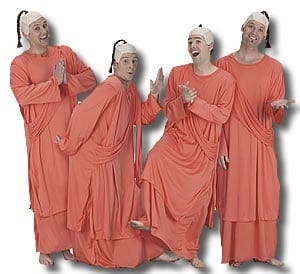I'm ACTUALLY a

Kasino asked me, “Are you like… full Hare Krishna?”—like maybe I was just posturing, playing the part ironically, the way some writers rock a tag like “Airpods” or “Nike” to be funny. Like maybe I’d still happily smoke a cone if someone offered. I laughed and said, “Yeah man, I try my best.”
I've been thinking about irony lately. It's one of my favourite things. Cringe humour is irony—it’s people doing things ironically. They display behaviour that someone with no self-awareness might do, but they’re doing it on purpose, which makes it funny, layered, and clever. My favourite graffiti is the same—deliberately bad, off-beat, or anti-style stuff. When I examine why it’s cool, it’s uber cool because it implies a full awareness of what is cool on the part of the artist—and on my part, the one appreciating it. There's this mutual wink, like, “Yeah, we know.”
Then Sitapati pointed out a type of irony I hadn’t really clocked before—ironic participation in devotional activities. Like when people say things like, “In our tradition, we…” or “Vedic culture says…”—instead of just being it. Just asserting it, living it. Our “Vedic wedding” was just our wedding. We weren’t trying to perform some cultural aesthetic—it was just us. When I wear a dhoti, it’s not a costume or a statement—it’s how I actually feel most myself. I’m not wearing it ironically, like a hipster with a beard pretending to be a lumberjack while riding a vintage bike to a pop-up café.
I’m actually a devotee of Krishna. And my graffiti is actually living in the 80s. I’m not pretending, not performing, not standing at a distance. To live ironically is to keep life at arm’s length. Everything becomes a joke, or just a commentary, instead of something lived. It’s like spiritual bypassing, but instead of being “above it,” you’re beside it—always observing, never committing.
Anyway, I randomly thought of the phrase “irony of irony” and typed it into AI. Turns out that’s actually a thing. Then I asked it if there are examples of this kind of layered irony in śāstra. Here’s what it gave me:
1. Hiranyakashipu and Prahlāda
Hiranyakashipu tries to become immortal so he can destroy Vishnu. His son becomes a pure devotee of that very same Lord. The more Hiranyakashipu fights God, the more he’s pulled into God's play. He gets destroyed not just by Vishnu, but by his own child’s devotion. The irony of irony.
2. Kṛṣṇa as Arjuna’s Charioteer
The Supreme Being becomes a humble chariot driver. Arjuna, the warrior, ends up getting taught by the one who’s technically serving him. God lowers Himself to elevate His friend. A cosmic role reversal.
3. Vṛtrāsura’s Liberation
The demon Vṛtrāsura turns out to be a hidden pure devotee. The one the devas fear is more spiritually advanced than Indra himself. And when Indra kills him, he gets purified and goes back to Godhead. Meanwhile, Indra is left to stew in guilt.
4. Duryodhana’s Death
He trains under Balarāma, fights for his vision of dharma, and dies through an unfair blow to the thighs—exactly where he was supposed to be invulnerable. The rules he clung to couldn’t protect him. That’s irony folded in on itself.
5. Śiśupāla’s Mokṣa
Śiśupāla hates Krishna with full obsession. He mocks Him, blasphemes Him—yet because his mind is so focused on Kṛṣṇa, when Kṛṣṇa finally kills him, he gets liberated. He hated his way back to God.
This thought has led me to rethink how I present things in my graffiti.
Like, instead of putting quote marks around my tags, I could just keep it clear. Not “Hare Krishna” - Just..
Hare Krishna!


